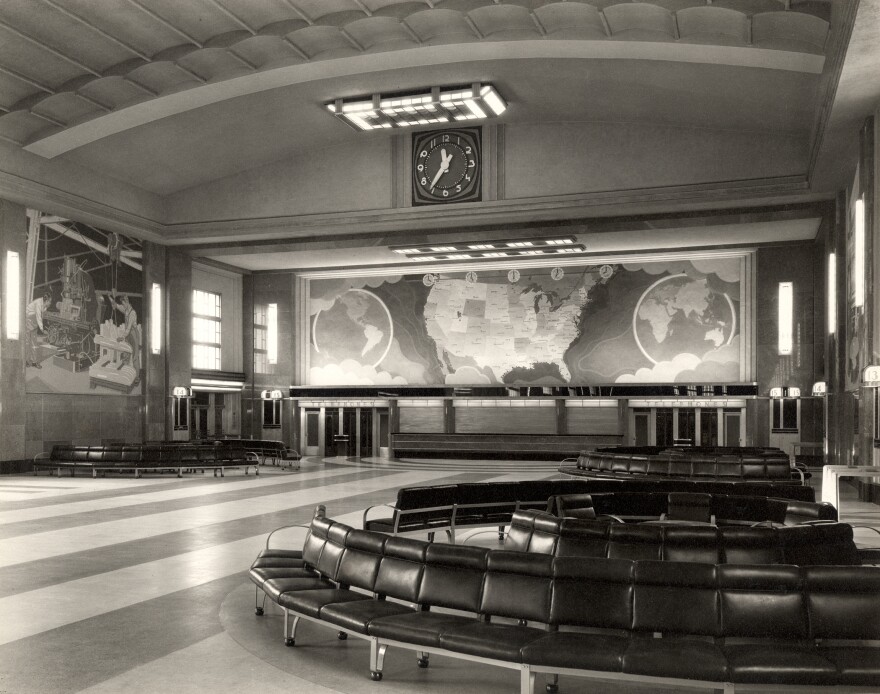You have questions about our community — questions that you're not sure have an easy answer — and you don't know who to ask. That's where our feature OKI Wanna Know comes in. This week, WVXU's Bill Rinehart counts up some local artwork.
Kelly Kelso of New Richmond is wondering about some murals you might have seen around Cincinnati and Northern Kentucky.
"My question is how many Winhold Reiss murals are there, and where are they now?" she asks. "I've only seen them in the Museum Center, but my brother said he saw some at the airport."
There are 22. But you want to know more, don't you?
OK, yes, there are some at the Cincinnati Museum Center, but exhibit specialist Nick Massa knows where they all are.
RELATED: What happened to Northern Kentucky's streetcars?
"There are, obviously, the two big ones in the rotunda, there's two back by the Omnimax Theater, and then there's four others scattered around the building," he says. "There are another nine at the Convention Center, and then five others out at the Greater Cincinnati airport."

But why are there so many Reiss murals here? Was the artist local?
No, says Massa. Winhold Reiss was born in Germany in 1886, and emigrated to the U.S. in 1913. "[He] established himself in New York. He spent some time in the early '20s out West with the Blackfeet tribe and then returned to New York and became a fairly well known interior designer and mural painter."
It was out West that Reiss made connections with railroad leaders. Massa says that's partly how he was chosen to create murals at what was then Cincinnati's new train station: Union Terminal.
RELATED: A bridge to nowhere reveals some local railroad history
"Cincinnati had earned a reputation as a city to avoid when traveling. We had five different stations. They were hard to get to. A lot of them were terminal ends for the lines, so you had to run from one station to another if you had a connecting train. It wasn't very convenient. You could get stuck here," Massa says. "They were also out of service a lot for flooding. They wanted this building to help change that perception of Cincinnati as being a city not to travel through or to visit."
Massa says the murals were a big part of that.
"It's really unusual for a train station to have this much artwork at all. There was a little over 18,000-square feet worth of art in the building when it opened," Massa says. "It's a showstopper. You don't expect it when you walk in."
Massa says Reiss created scale paintings, and then a company called Ravenna Tile reproduced them three times the original size on the walls with colored plaster and tiles.
"When Ravenna made their pitch to the terminal company to do this mural project, they weren't originally specified to be mosaic tile," Massa says, "But their concept was really bright, very colorful, easy-to-maintain murals, along with Reiss's reputation as an artist as the base artwork was too good to pass on."
It seems it was a good decision. Massa says tile doesn't fade or tarnish like an oil painting mural would, and when they got dirty from years of smoke and dirt, all you had to do was wipe them down.
However, the murals as we know them, almost never came to be.
"When they had to start tightening the budget because of the Depression, in 1932, the board actually requested a quote from Ravenna, saying 'What's it going to cost to finish, versus to tear out what you put in, and just put regular plaster up?' " Massa says. "Ravenna didn't give them an answer, they just said 'We'll finish it for $6,000.' And the board said, 'Good enough.' "
Most of the murals stayed at Union Terminal until 1973. The concourse was going to be torn down because fewer people were riding trains. Fourteen murals were relocated to the Cincinnati Northern Kentucky International Airport.
RELATED: What's with the finger pointing at CVG?
But Massa says there's one that never made the journey.
"We did lose one when they demolished that part of the [train] building. There was a big 80-foot by 20-foot mural that was too large to move. So that was demolished with the rest of the structure."

The lost mural was a giant map. The original painting was on display in Union Terminal inside the Cincinnati History Museum until renovations started in 2016. It was moved to CVG and has been "welcoming travelers" since then, according to Museum Spokesman Cody Hefner.
RELATED: What lies beneath downtown Cincinnati?
Five murals are still at CVG today. The other nine were moved to the western wall of the Convention Center on Central Avenue because the airport concourse they were in was going to be torn down.
This story has been updated.
If you have an offbeat question about the area, ask OKI Wanna Know by filling out the form below.




